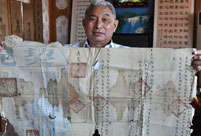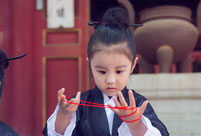

SINGAPORE, Feb. 14 -- Chocolate is a must-have as a gift on Valentine's day, but many store-bought chocolates are not as authentic as one might think and as much as seventy percent of the chocolate bought and sold in the Asia Pacific region is in fact not "real."
The two may look no different, but they are distinct in essence. In the cheaper compound the manufacturers substitute chocolate liquor and cocoa butter, with cocoa powder and vegetable oil.
"In Europe, if chocolate contains more than 5 percent vegetable oil, it cannot be called 'real chocolate.' Said Mikael Neglen, President of Chocolate Asia Pacific of Barry Callebaut, one of the world's leading manufacturers of high-quality chocolate and cocoa products.
Neglen also noted that different countries adopt their own criteria. "For instance, in India, they don't allow vegetable oil in chocolate, which means, all the chocolate sold in India is ' real chocolate.'"
Talking about why the market share of compound chocolate is larger in the Asia Pacific region, Neglen attributed it to the preference of local consumers.
"If the first chocolate they've tried are compounds, they get used to the flavor and if you give them something different, they might not accept it," he said, adding that they have seen a growing market share of real chocolate in this region.
Given the complicated procedure in separating cocoa butter, the cost of compound chocolate is much lower. But it's redundant to say compound chocolate is bad, explained Paul Lechevalier, Research & Development Director for Chocolate Asia Pacific of Barry Callebaut, because by adding some vegetable oil, they can change the characteristics of traditional chocolates, such as its heat-resistance.
The regular melting point of chocolate is around 36 degrees centigrade, but compound chocolate can push it up to 40 or even 50 degrees centigrade, which is good news for consumers in the southeast
Asian markets, like Singapore, sees chocolate easily melt under normal temperatures, a staff at the Barry Callebaut chocolate factory in Singapore told Xinhua, during a recent tour of its production line.
Another interesting thing experts from Barry Callebaut said is how to tell when chocolate has gone bad.
The shelf life for chocolate is one year for white chocolate; one and a half year for dark and milk chocolate and two years for compound ones, but it still depends on the storage conditions.
The bad news is, is it's hard to tell from its flavor as it won 't taste much different, said Andres Lara, Executive Pastry Chef for Chocolate Asia Pacific of Barry Callebaut.
He went on to explain that if the chocolate has been kept in hot and cold temperatures, it would develop a layer of grease on the top, which could be used as a way to check the quality.
 PLA soldiers operating vehicle-mounted guns in drill
PLA soldiers operating vehicle-mounted guns in drill Beauties dancing on the rings
Beauties dancing on the rings Blind carpenter in E China's Jiangxi
Blind carpenter in E China's Jiangxi Top 10 highest-paid sports teams in the world
Top 10 highest-paid sports teams in the world In photos: China's WZ-10 armed helicopters
In photos: China's WZ-10 armed helicopters UFO spotted in several places in China
UFO spotted in several places in China Certificates of land title of Qing Dynasty and Republic of China
Certificates of land title of Qing Dynasty and Republic of China  Cute young Taoist priest in Beijing
Cute young Taoist priest in Beijing New film brings Doraemon's life story to China in 3D
New film brings Doraemon's life story to China in 3D Obama is sowing discontent in S.China Sea
Obama is sowing discontent in S.China Sea Rescuers work through night to reach cruise ship survivors
Rescuers work through night to reach cruise ship survivors Driving through limbo
Driving through limbo Facing down MERS
Facing down MERSDay|Week